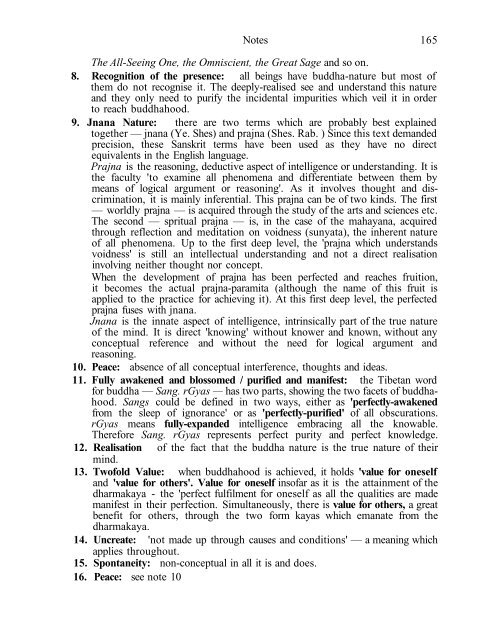The Changeless Nature
The Changeless Nature
The Changeless Nature
- No tags were found...
You also want an ePaper? Increase the reach of your titles
YUMPU automatically turns print PDFs into web optimized ePapers that Google loves.
Notes 165<strong>The</strong> All-Seeing One, the Omniscient, the Great Sage and so on.8. Recognition of the presence: all beings have buddha-nature but most ofthem do not recognise it. <strong>The</strong> deeply-realised see and understand this natureand they only need to purify the incidental impurities which veil it in orderto reach buddhahood.9. Jnana <strong>Nature</strong>: there are two terms which are probably best explainedtogether — jnana (Ye. Shes) and prajna (Shes. Rab. ) Since this text demandedprecision, these Sanskrit terms have been used as they have no directequivalents in the English language.Prajna is the reasoning, deductive aspect of intelligence or understanding. It isthe faculty 'to examine all phenomena and differentiate between them bymeans of logical argument or reasoning'. As it involves thought and discrimination,it is mainly inferential. This prajna can be of two kinds. <strong>The</strong> first— worldly prajna — is acquired through the study of the arts and sciences etc.<strong>The</strong> second — spritual prajna — is, in the case of the mahayana, acquiredthrough reflection and meditation on voidness (sunyata), the inherent natureof all phenomena. Up to the first deep level, the 'prajna which understandsvoidness' is still an intellectual understanding and not a direct realisationinvolving neither thought nor concept.When the development of prajna has been perfected and reaches fruition,it becomes the actual prajna-paramita (although the name of this fruit isapplied to the practice for achieving it). At this first deep level, the perfectedprajna fuses with jnana.Jnana is the innate aspect of intelligence, intrinsically part of the true natureof the mind. It is direct 'knowing' without knower and known, without anyconceptual reference and without the need for logical argument andreasoning.10. Peace: absence of all conceptual interference, thoughts and ideas.11. Fully awakened and blossomed / purified and manifest: the Tibetan wordfor buddha — Sang. rGyas — has two parts, showing the two facets of buddhahood.Sangs could be defined in two ways, either as 'perfectly-awakenedfrom the sleep of ignorance' or as 'perfectly-purified' of all obscurations.rGyas means fully-expanded intelligence embracing all the knowable.<strong>The</strong>refore Sang. rGyas represents perfect purity and perfect knowledge.12. Realisation of the fact that the buddha nature is the true nature of theirmind.13. Twofold Value: when buddhahood is achieved, it holds 'value for oneselfand 'value for others'. Value for oneself insofar as it is the attainment of thedharmakaya - the 'perfect fulfilment for oneself as all the qualities are mademanifest in their perfection. Simultaneously, there is value for others, a greatbenefit for others, through the two form kayas which emanate from thedharmakaya.14. Uncreate: 'not made up through causes and conditions' — a meaning whichapplies throughout.15. Spontaneity: non-conceptual in all it is and does.16. Peace: see note 10
















